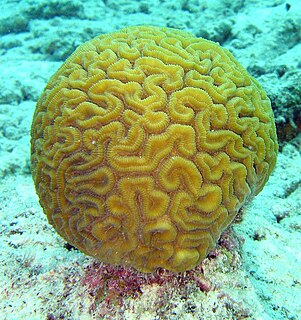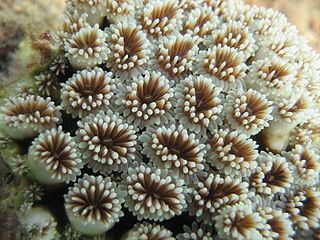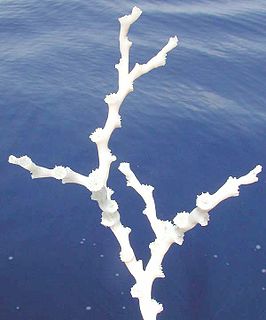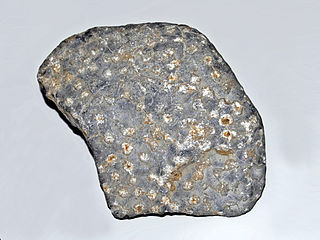 W
WAntipatharians, also known as black corals or thorn corals, are an order of soft deep-water corals. These corals can be recognized by their jet-black or dark brown chitin skeletons, surrounded by the polyps. Antipatharians are a cosmopolitan order, existing at nearly every location and depth, with the sole exception of brackish waters. However, they are most frequently found on continental slopes under 50 m (164 ft) deep. A black coral reproduces both sexually and asexually throughout its lifetime. Many black corals provide housing, shelter, food, and protection for other animals.
 W
WAntipatharians, also known as black corals or thorn corals, are an order of soft deep-water corals. These corals can be recognized by their jet-black or dark brown chitin skeletons, surrounded by the polyps. Antipatharians are a cosmopolitan order, existing at nearly every location and depth, with the sole exception of brackish waters. However, they are most frequently found on continental slopes under 50 m (164 ft) deep. A black coral reproduces both sexually and asexually throughout its lifetime. Many black corals provide housing, shelter, food, and protection for other animals.
 W
WColpophyllia is a genus of stony corals in the family Mussidae. It is monotypic with a single species, Colpophyllia natans, commonly known as boulder brain coral or large-grooved brain coral. It inhabits the slopes and tops of reefs, to a maximum depth of fifty metres. It is characterised by large, domed colonies, which may be up to two metres across, and by the meandering network of ridges and valleys on its surface. The ridges are usually brown with a single groove, and the valleys may be tan, green, or white and are uniform in width, typically 2 centimetres. The polyps only extend their tentacles at night.
 W
WCycloseris is a genus of solitary disc corals in the family Fungiidae. They are found in the Indo-Pacific. They inhabit the lower reef slopes, and the areas between reefs with soft sediments. They tolerate turbid waters.
 W
WCyphastrea is a genus of massive reef building stony corals in the family Merulinidae, commonly known as brain coral.
 W
WDichocoenia is a monotypic genus of stony coral in the family Meandrinidae. It is represented by a single species, Dichocoenia stokesii, which is commonly known as pineapple coral, elliptical star coral, or pancake star coral. It is found in the Caribbean Sea and the western Atlantic Ocean. Dichocoenia stokesii has irregular calyces and its form can be either a massive, hemispherical hump or a flat, platform-like structure.
 W
WDiploria is a monotypic genus of massive reef building stony corals in the family Mussidae. It is represented by a single species, Diploria labyrinthiformis, commonly known as grooved brain coral and is found in the western Atlantic Ocean and Caribbean Sea. It has a familiar, maze-like appearance.
 W
WGoniopora stokesi is a species of colonial stony coral. As with other species in genus Goniopora, it has the common names 'flowerpot coral' and 'daisy coral'. The International Union for Conservation of Nature (IUCN) categorises its status as near threatened.
 W
WHeterocyathus aequicostatus is a small species of coral in the family Caryophylliidae in the order Scleractinia, the stony corals. It is native to the Indo-Pacific region. It is a large polyp, solitary, free-living coral and is usually found on soft substrates.
 W
WIsastrea is an extinct genus of corals that lived during the Jurassic and Cretaceous periods. Its fossils have been found in Europe, Africa, North America, Asia and South America.
 W
WLeptastrea is a genus of massive reef building stony corals known primarily from the Indo-Pacific. Although previously assigned to Faviidae, Budd et al. (2012) assigned it to Scleractinia incertae sedis based on phylogenetic results demonstrating the polyphyly of Faviidae.
 W
WLophelia pertusa, the only species in the genus Lophelia, is a cold-water coral which grows in the deep waters throughout the North Atlantic ocean, as well as parts of the Caribbean Sea and Alboran Sea. L. pertusa reefs are home to a diverse community, however the species is extremely slow growing and may be harmed by destructive fishing practices, or oil exploration and extraction.
 W
WMycetophyllia is a genus of stony corals in the family Mussidae, commonly known as ridged cactus corals. Members of this genus are native to the Caribbean area. They are zooxanthellate species and are sometimes kept in reef aquaria.
 W
WPorites lutea is a species of stony coral in the family Poritidae. It is found growing in very shallow water on reefs in the Indo-Pacific region. It sometimes forms "microatolls" in the intertidal zone and these massive structures have been used to study trends in sea levels and sea water temperature.
 W
WRhabdophyllia is an extinct genus of stony corals.
 W
WTurbinoliidae is a family of reef building stony corals.